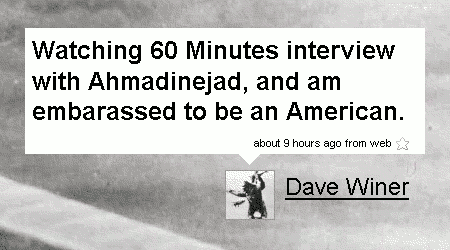I probably don’t say it often enough, but Jason Calacanis is one of the role models I look up to when it comes to entrepreneurship. He’s also a great person and a great friend when I really needed it most. Let this serve as a disclaimer that any perceived hate in this blog entry is entirely unintentional.
I was reading his latest update about Mahalo and something really made me ask WTF? Here’s the key sentence:
[Jason Hines] pointed out all the salient issues, answered the burning questions, and come to the same conclusions we have over the past eight months since launch: social search has great potential.
“… social search has great potential.”
I thought I understood what Mahalo’s feature set currently is. I thought I understood what social software is. I thought I understood what social search is. But, that quote leads me to understand that Jason is suggesting that he thinks Mahalo is social search. Am I right, Jason?
Mahalo isn’t social search, in my mind. It isn’t even “Web 2.0” in my book because for me, Web 2.0 applications increase in value the more users perform the primary function of the application (i.e., network effect). Mahalo is a blend of yesteryear’s Yahoo! directory-oriented web categorization, presented in a manner that’s friendly to a generation of users who have been trained on how to better craft search queries to find what they’re looking for.
Perhaps I can quickly describe, at a low level of detail, what I consider to be a “social search” product, see if you agree, and then decide if Mahalo fits. Or, any other currently existing web product out there, for that matter.
Social search, in a nutshell, means:
- Users create profiles, identify themselves to the system.
- Users describe their relationships to other users in the system.
- Users perform web searches using the system. The system tracks what results they click through to, and of those, users describe whether the result was useful in satisfying their search or not.
- When users perform web searches, results their friends indicated were useful rank higher in results.
- The more people search and provide feedback, the better the results will be for their friends when they search.
- When users feel they have found the best result for their search, they can communicate their search query and the best result to their friends through the system.
This is social software because it creates an environment where people can define relationships that are meaningful to the application. The reason this fits my definition of Web 2.0 is that it continues to improve in quality (thus, increase in value) the more it gets used.
There’s plenty of social networking sites across many verticals already. There’s plenty of search engines already, and I’m sure they track all sorts of things including click-throughs. There’s plenty of sites where people can vote on links to pages and comment on them. There’s plenty of sites where people can bookmark links and share them with their friends.
Is there a product out there that combines all this data and uses it to enrich search results in realtime? I could see this as being done as a browser plugin … you authenticate to the social search service through it, then allow it to track your web surfing activity–which is probably the reason why Jason pushes Mahalo Follow really hard–and you then vote on pages that you like/dislike the way StumbleUpon lets you, with a quick yes/no. The plugin would handle actions on certain sites with special code, like when a user saves a page to their del.icio.us bookmarks or when they Digg it, letting the system know that they think the page is particularly valuable. This could even work for improving image search, when users search for images, in addition to presenting the images as results, there were some way to indicate “yes, when I searched for [xyz], these images from the result set were what I was looking for.” Expert systems in AI haven’t really gotten us very far, but this seems like a really good way to fake it.
Ultimately, the challenge would be to build a search index where pages users have expressed explicit preference for would be ranked higher in search results for that user and their friends. Right now, Mahalo either sends you to their very limited set of manually-created result pages or to one of various other search engines–but, it’s not clear if and how any of the Mahalo-collected data on its users is used to influence the order of the search results as returned by these other search engines. I don’t know if that would violate whatever agreement Mahalo has with them, or the ToS of these search services in general.
Look, I realize people are probably asking themselves, “why do we care what you think, Dossy? Jason’s the one with the millions of dollars from his self-made success, and you’re just picking nits here,” but doesn’t it seem odd that after 10 years, the search space ought to be mature enough that such a product would emerge and give all the old “Web 1.0” search engines a real run for their money, don’t you think?
Have I got this all wrong? Is there already a startup or product out there that I just haven’t heard about? I know several incomplete efforts have come and gone in the past, but I think the reason none of those have really taken a huge lead is because they need all these attributes I described in order to truly win. Just implementing one or two parts may be useful in a particular area, but it’s the whole package that will really change the way we use the web.
Tags: Jason Calacanis, Mahalo, social search





Latest comments